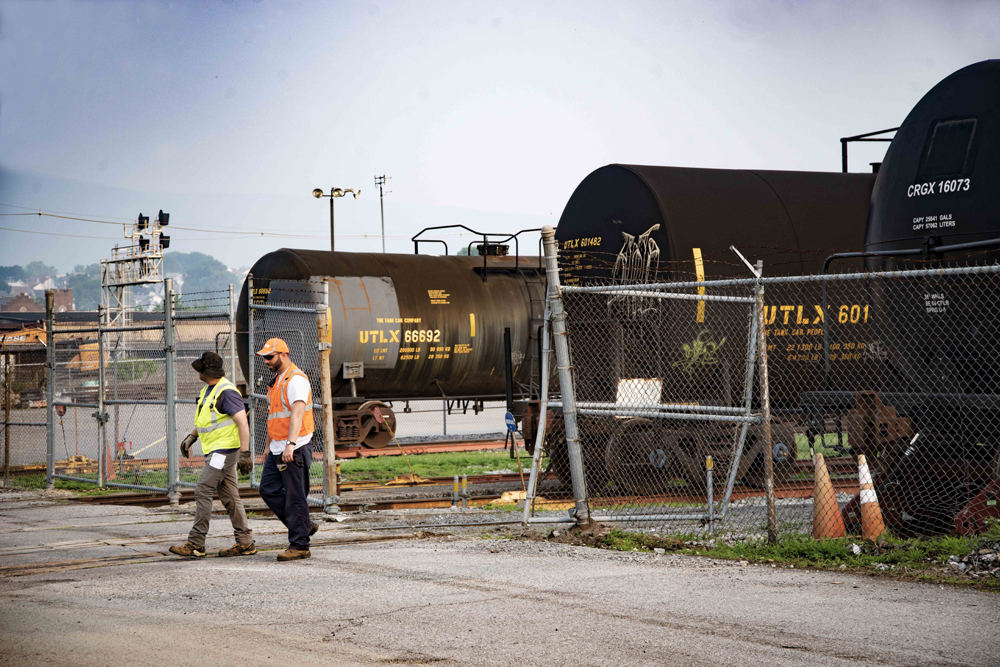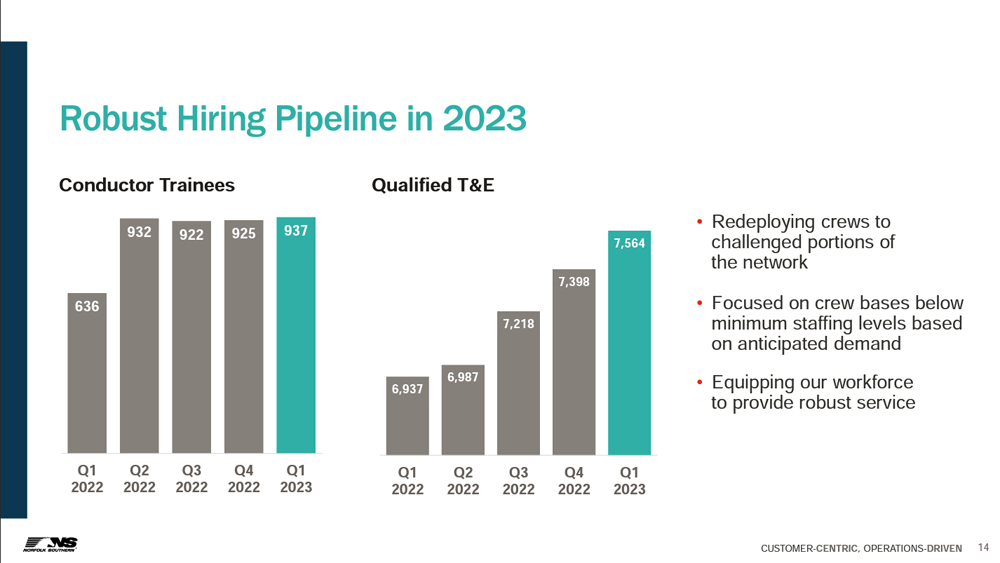
WASHINGTON — The Federal Railroad Administration is demanding immediate changes to Norfolk Southern’s conductor trainee program, citing “grave deficiencies” that have been marked by incidents resulting in “amputations and other serious injuries.”
In a June 14 letter, Allison Ishihara Fultz, FRA’s chief counsel, wrote that despite nearly two years of FRA working with NS to improve the program, the railroad still “has not developed an adequate conductor certification program.
“FRA’s ongoing audit of [the NS program] has laid bare grave deficiencies that NS must rectify immediately,” she wrote. “The magnitude and significance of these shortcomings, especially in the context of the large number of hires currently undergoing training, necessitate swift and decisive action on NS’ part.”
“During the audit, FRA has observed new hires grappling to comprehend, internalize, and retain the critical safety information presented in training. New hires without previous railroad experience need adequate time and relevant exposure to the railroad environment to absorb its specialized language, procedures, and safety protocols.”
The FRA demanded a detailed action plan and a timeline for implementation within 90 days, including “a schedule for re-training those conductors who were trained under the non-compliant program.”
The audit found three major flaws:
— “The 13-day window for training in NS’ conductor training program, is grossly inadequate, allowing certification in an unacceptably brief period. This is incompatible with the demands of a Class I freight railroad.” In an email to Trains News Wire, NS spokesman Connor Spielmaker wrote: “We believe the FRA was referring to the instruction time at the McDonough [Ga.] training facility, which is a three-week, Monday-Friday program prior to OJT [on-the-job-training]. However, this is only a part of the conductor trainee program which averages four months total.”
— “NS’ current on-the-job field training lacks consistency, structure, and proper oversight,” the letter said. As an example, it said when trainees were assigned to a terminal, managers at those terminals had no process to follow. The FRA also was critical of the lack of training coordinators to help trainees transition from the classroom to on-the-job training, and said evaluation forms used for on-the-job training were “significantly less comprehensive” than those at the training center.
— The railroad also failed to comply with FRA regulations by designating “qualified instructors” without obtaining required concurrences from employee representatives.
“Given the gravity of these concerns,” Fultz wrote, “NS’s responsibility to comply with federal rail safety requirements and ensure comprehensive training for newly hired individuals cannot be overstated.”
Failure to comply, FRA warned, will result in enforcement action by the agency and a report to Congress, including “relevant Senate and House committees.”
NS responds

NS’s Spielmaker told News Wire, “We are committed to setting the standard for safety in the railroad industry. We take seriously our extensive program of classroom and on-the-job conductor training, and we are taking a series of immediate actions to build on that program to address the FRA’s concerns. We have also contacted the FRA to initiate further discussions on the actions they recommend. We have also shared the letter with ANS, our new independent safety consultant, and asked them to begin a review to supplement our own efforts. Finally, as we have demonstrated, we are committed to collaborating with our unions and craft railroaders to improve our safety culture, including training, and we look forward to engaging with them on this effort.
“We’ve since responded to the FRA, and wanted to include some excerpts:
— “New trainees report to the NS Training Center in McDonough, Ga., on their first day of employment with NS and spend their first three weeks receiving classroom and applied instruction and performing hands-on physical and classroom tasks designed for education on, and repetition of, the most common tasks a conductor is expected to perform. Trainees are required to demonstrate proficiency in many physical tasks, including mounting and dismounting equipment, properly lining switches and derails, protecting shove moves, leaving equipment in the clear, and securing equipment.
— “They also must pass a series of examinations covering topics such as operating rules knowledge, signal aspect and indication proficiency, power brake law compliance, and hazardous material handling. Only after a trainee demonstrates the requisite knowledge and physical ability to safely continue his or her training during the first three weeks at the NS Training Center will he or she proceed to the next stage in the field, which is on-the-job training.
— “OJT is scheduled based on the trainee’s seniority district and is coordinated among Training Coordinators, Technical Training staff, Transportation supervisors, and craft mentors to cover the types of territorial work to be performed as a certified conductor. The team of Training Coordinators, Transportation supervisors, and craft mentors are involved in scheduling and executing training schedules to ensure a trainee has the knowledge and experience necessary to obtain promotion as a certified conductor.
— “Field Orientation Checklist: We will issue a Field Orientation Checklist to standardize the orientation process across the network. This checklist will ensure that trainees leave the NS Training Center with a clear set of expectations when transitioning to OJT. Training Coordinators, assisted by our craft mentors and Transportation supervisors, will provide systemwide oversight to ensure these transition activities are handled consistently at each field location. The list will be distributed electronically to allow tracking of completion. In combination with the Qualification Book, this list will create consistency in the transition from the NS Training Center to OJT as well as provide clarity on the roles of the trainee, craft mentor, and Transportation supervisor.
— “Recurrent Training for all Employees who Oversee Conductor Training: We will develop and deliver a recurrent training course to all conductors (who have or are nearing 12 months of conductor service), Transportation supervisors, and Training Coordinators that provides specific guidance regarding the OJT program.”
Like other Class 1 roads, NS laid off hundreds of train-and-engine-service employees in the wake of adopting TOP-21, its version of the controversial, bottom-line-driven Precision Scheduled Railroading operating model, and of undergoing the effects of the COVID pandemic. The result was a shortage of rested crews, days-long train delays, and shipper and consignee complaints that have reached the ears of federal elected and career officials.
Story continues below

Spielmaker provided statistics showing that NS had 937 conductor trainees in its pipeline during the first quarter of 2023, compared to 636 in the same period of 2022. Overall, the qualified train-and-engine staff has risen to 7,564 in the first quarter of 2023 from 6,937 in the same period of 2022.
Hiring and retaining T&E crews is challenging for all Class 1s because of unpredictable on-call hours requiring night, weekend, and holiday work in all weather conditions; extremely limited ability to mark off from duty for sick-day and family obligations; and zero-tolerance standards for drug and alcohol use in a safety-critical environment.
Contacted by News Wire, SMART-TD, the union that covers most conductors, referred News Wire to its newsletter. The other union representing conductors, the Brotherhood of Locomotive Engineers and Trainmen, did not respond to a query.














I worked for NS in Princeton, IN. I went to GA in December and came back December 23rd, I started my OJT training on January 3rd, February I had gotten Covid from one of my trainers and along woth covid I had Pneumonia, I was off for 2 weeks and said they would let me make that time up, well they put me on coal trains and where I was stationed at, we would get on the train at the power plant and take it to the coal mine to get filled or get on at the coal mine and take it to the power plant. Coal trains you hardly ever cut cars, or cut air in, you spend more time in a load out tower watching the train be filled or you are on the train going to the power plant, so another words I didn’t learn shit on coal trains and expected me to be ready in 2 and a half months. I also part of my time training I had conductors that have been promoted to conductors less than a year so I wasn’t able to get on the ground and see or do I was expected to learn, yet once again they said they would make up for it and I was expected to certify in 2 1/2 months after I got back from GA. NS is a big joke and they preach safety but they don’t give a crap about their employees, they only care about the money they make.
The bar graphs look fishy. The trainee graph shows 636 in Q1 2012 and 922 to 937 in each of the next four quarters, implying they trained 4352 T&E employees.
The displayed lengths of the bars on the Qualified T&E graph implies their number more than doubled, but the numbers actually show 6937 in Q1 2012 and 7564 in Q1 2013, an increase, but only 627.
Of 4352 trainees, they only qualified 627?
NS better hope the FRA does not bring the Gillentine onto NS. That is decertify a bunch of conductors. Can you imagine the black eye for all US RRs? Plus the delayed cancelled freights and some Amtraks caught behind same.
“The FRA demanded a detailed action plan and a timeline for implementation within 90 days, including “a schedule for re-training those conductors who were trained under the non-compliant program…” OR WHAT? Enforcement action by the agency and a report to Congress… So What? If this is that critical, perhaps a 10 million dollar initial fine and daily fines of $100,000.00 per day the situation goes unresolved is in order.
Just making threats does not solve the problem. The only thing these railroads understand is a hit to their bottom lines. Are they making changes…. apparently yes. But once the rancor dies down, at least until the next problem or disaster, it will be “status quo, Uncle Joe” until their hand is forced. Don’t add regulations unless someone is intent on enforcing it. And the only enforcement that will make a difference is large, very large fines. What got NS to move on East Palestine? A host of possible lawsuits from state and federal agencies as well as the citizens of East Palestine. And suddenly NS began to “understand” that business as usual in this case was not going to work.
As far as the NS reply, the key component, “Field Orientation Checklist” sounds like a typical railroad “blame sheet” a record to hold harmless the railroad and blame the employee when things go wrong. The problem with this is the railroads still don’t get that management is not the railroad! The employees are the railroad, the ones doing the work. Failure is an opportunity to better the employee through training not an excuse to fire someone… Until these attitudes truly become the backbone of operating a railroad, nothing will ever change.